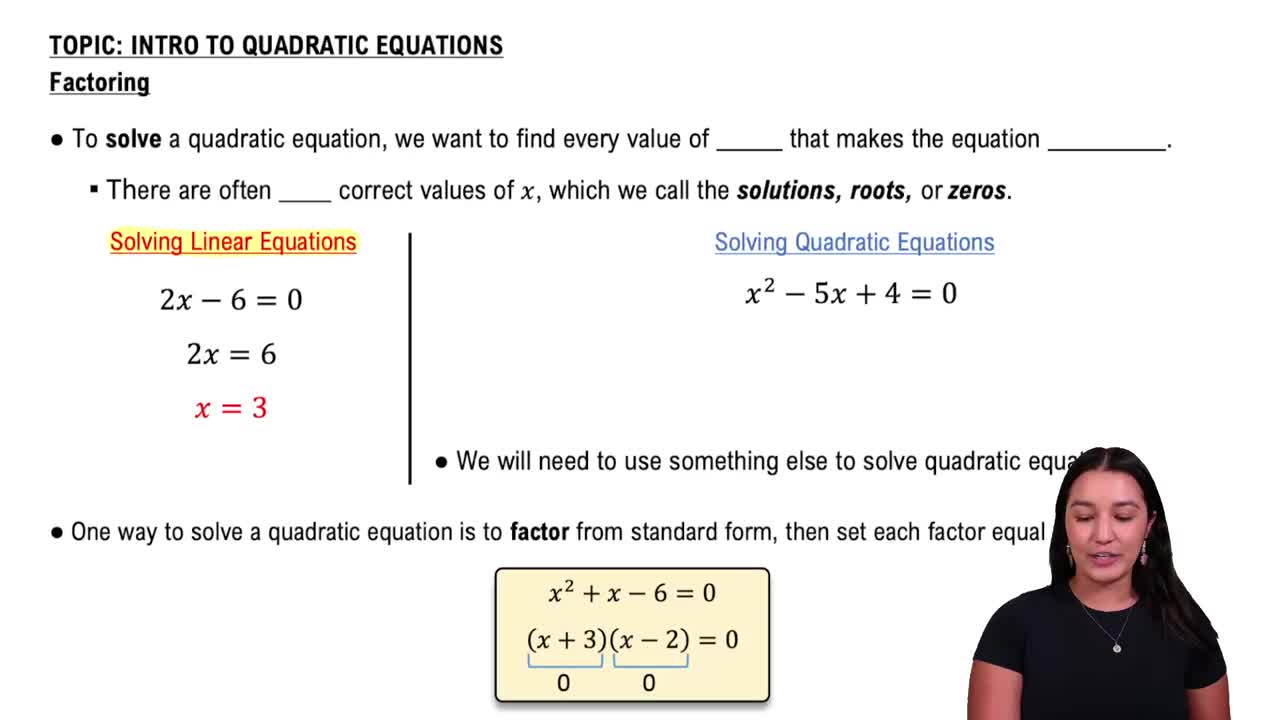Table of contents
- 0. Review of Algebra4h 16m
- 1. Equations & Inequalities3h 18m
- 2. Graphs of Equations43m
- 3. Functions2h 17m
- 4. Polynomial Functions1h 44m
- 5. Rational Functions1h 23m
- 6. Exponential & Logarithmic Functions2h 28m
- 7. Systems of Equations & Matrices4h 6m
- 8. Conic Sections2h 23m
- 9. Sequences, Series, & Induction1h 19m
- 10. Combinatorics & Probability1h 45m
1. Equations & Inequalities
Linear Inequalities
Problem 43e
Textbook Question
Solve each quadratic inequality. Give the solution set in interval notation. See Exam-ples 5 and 6. 2x^2-9x≤18
 Verified step by step guidance
Verified step by step guidance1
First, rewrite the inequality in standard form by moving all terms to one side: \(2x^2 - 9x - 18 \leq 0\).
Next, factor the quadratic expression \(2x^2 - 9x - 18\). Look for two numbers that multiply to \(-36\) (the product of \(2\) and \(-18\)) and add to \(-9\).
Once factored, the expression should look like \((2x + a)(x + b) \leq 0\), where \(a\) and \(b\) are the numbers found in the previous step.
Determine the critical points by setting each factor equal to zero: \(2x + a = 0\) and \(x + b = 0\). Solve these equations to find the values of \(x\).
Use the critical points to test intervals on the number line. Choose test points from each interval to determine where the inequality \((2x + a)(x + b) \leq 0\) holds true, and express the solution set in interval notation.
Recommended similar problem, with video answer:
 Verified Solution
Verified SolutionThis video solution was recommended by our tutors as helpful for the problem above
Video duration:
6mPlay a video:
Was this helpful?
Key Concepts
Here are the essential concepts you must grasp in order to answer the question correctly.
Quadratic Inequalities
Quadratic inequalities are expressions that involve a quadratic polynomial set in relation to a value using inequality symbols (e.g., ≤, ≥, <, >). To solve these inequalities, one typically finds the roots of the corresponding quadratic equation and then tests intervals to determine where the inequality holds true.
Recommended video:
Guided course

Nonlinear Inequalities
Interval Notation
Interval notation is a mathematical notation used to represent a range of values. It uses parentheses and brackets to indicate whether endpoints are included (closed interval) or excluded (open interval). For example, (a, b) represents all numbers between a and b, not including a and b, while [a, b] includes both endpoints.
Recommended video:

Interval Notation
Factoring Quadratics
Factoring quadratics involves rewriting a quadratic expression as a product of its linear factors. This is essential for solving quadratic equations and inequalities, as it allows one to find the roots easily. For example, the quadratic expression ax^2 + bx + c can often be factored into (px + q)(rx + s), where p, q, r, and s are constants.
Recommended video:

Solving Quadratic Equations by Factoring
Related Videos
Related Practice













